The 2018 World Cup has arguably been the greatest we have ever witnessed. The introduction of VAR, despite it's critics, has seen an average of 5 fewer fouls per game compared to 2014. Kylian Mbappe burst onto the World Stage. We have potentially seen the last standout international performance from both of the greatest players in the last 10 years (Ronaldo v Spain, Messi v Nigeria). The capitulation of the Germans. 5/6 goals that all had a claim for goal of the tournament.
And of course, Michi Batshuayi creating a new goal celebration...
As a fan, the competition has been a treat. As a coach, even of the foundation age group, there has been a lot that we can take from it as well.
Speed Kills

Kylian Mbappe was easily the breakout star of the 2018 World Cup. Having signed for Paris St Germain the previous summer (initially on loan with a £166million fee due this summer), Football fans and coaches alike were aware that he is a talent. The World Cup has highlighted just how much of a talent he is!
There are many things that we could highlight about Mbappe. His calmness under pressure, the close control he displayed under tight marking and the goals he scored all stand out. Yet most impressive was the explosive speed he showed. The way he burst past the Argentina defence in the last 16 game brought many to their feet.
At all levels of the game, speed combined with control is a dangerous combination for any player to possess. Add game intelligence to that and a potential superstar could be on your hands.
Activity - Coerver Speed Square
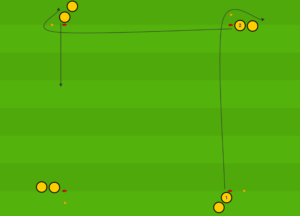
Set up a 10x10 square with an even number of players at each corner (minimum of 2 per cone). Walk around the square in an anti-clockwise direction and place a different coloured cone 3 yards past each cone.
Player 1 starts off by sprinting past the cone in front of them, onto the second cone and join the back of the new line. As soon as they pass the player standing at the cone (player 2), that players sprints to the next cone. Continue.
Progression 1
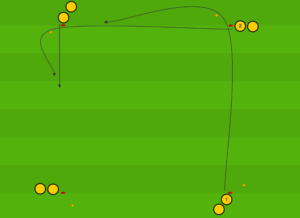
Turn it into a tag game. As soon as player 1 passes the second game, they sprint and chase the player in front of them. Continue with each player making 2 sprints - 1 to get away, 1 to chase.
Progression 2
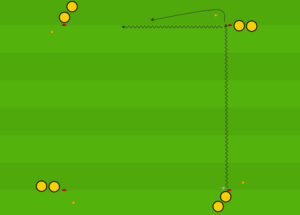
The player escaping now has a ball. They stop the ball in front of the player at the next cone before exploding around the second cone and chasing them. Build to 2 pairs going at the same time.
Why it works
The players have to accelerate quickly to get away from pressure. 2 very realistic sprints occur - 1 in possession (getting away from an opponent) and 1 out of possession (chasing an opponent). The ball adds an element of controlled running with the ball, an important skill for when players have space in front of them in games.
Set Piece Rock Stars

It could be argued that the introduction of VAR saw far less fouls occur in the penalty box (except for the England v Panama game) then may have happened otherwise. In total, we saw 43% of all goals at the 2018 World Cup scored via a set piece. England reached the semi-finals on the back of 9 of their 12 goals being scored from free kicks, corners or penalties. Even the final, so often a game that summarises the entire competition, saw all 3 first half goals scored from set plays.
Set piece practice for foundation age players should be a big no-no during the regular season. Players have far more important things to work on to benefit their long term development. That doesn't mean that we can't have fun with it prior to tournaments. With teams playing as many as 4 games in one weekend, set piece practice allows for a more relaxed final session before the tournament.
It also allows players to stretch their creative muscles. Rather than designing the set plays yourself, give them a chance to come up with an idea. By suggesting a few possibilities, a homework task can be given for players to design a corner/free kick routine. After trying them out, a vote can be made to decide which set piece will be used at the next tournament.
How it Works
Print and hand out (or e-mail) this set piece design sheet to your players. Allow them to choose a corner or free kick routine, detailing the designated set play takers and signals to determine where the ball will be aimed towards. Remind your players that they will need to consider the defensive side of things in case the ball is lost. All starting players will need to be drawn on the sheet.
Test them out at the practice prior to a tournament. Run through each one 3-4 times and guage the players reaction to them.
Be Clinical

Possession football is not dead. Despite Spain's best efforts against Russia (in which their play seemed to have no real purpose), teams with positive intentions have been able to dominate the ball in games and create plenty of chances. Think Brazil v Belgium. Germany against Mexico and even Croatia in the final against France.
Unfortunately, for the teams that lost, as well as dominating the ball and creating chances, their finishing let them down massively. Against Brazil, Belgium had the same amount of total chances as their opponents had ON TARGET, yet they came away 2-1 winners. Germany, despite some atrocious defending, had double the amount of chances that Mexico created, yet came away having not scored. Croatia created seven goal-scoring opportunities compared to France's ONE. They still found themselves 2-1 down at half time.
Taking chances has and always will be important in Football. The 2018 World Cup reminded us of this. We can have the greatest build up play in the World, but if the ball ends up with the opponents Goalkeeper, it has all been for nothing.
Some will tell you that line drill type activities don't work. I believe that they can and do work. They teach certain mechanics, such as lifting your head and placing the plant foot. As long as they are high intensity and with small numbers, players won't get bored. My old U8's used this activity and turned into very composed, calm and clinical finishers in games. Not bad for a group whose sole aim to begin with was to toe the ball as hard as they could!
Activity - Dribble and Shoot
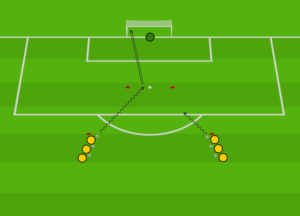
Set up 2 lines with a maximum of 3 players each. All players have a ball. The first player in the right line dribbles in between the 2 cones in front of them and finishes with their left foot. After shooting they get the ball and join the other line. The first player in the left hand line dribbles in and finishes with the right foot. Continue.
Progression 1

Half of the group have balls, half don't. The first player with the ball dribbles and leaves it in between the cones. As soon as the ball is stopped, they first player without the ball runs and hits a first time finish. Continue and switch sides after 2/3 minutes.
Progression 2

Have the player dribbling and stopping the ball run around a second cone before applying pressure to the finisher.
Why it Works
As coach, you can break down the 3 main coaching points of finishing - LOOK (at the goal), DECIDE (where to shoot) and AIM (point your plant foot). Players get repetition of these 3 coaching points so that it becomes innate. Most young players, U8's especially, tend to shoot when running in a straight line to the ball. The angle of the player dribbling/running in is realistic to what they would expect in a game. Players become comfortable with both feet - a lot of finishing issues with the non-preferred foot come from poor plant foot placement. This allows the coach to help correct those issues. First time finishing is introduced from the age of U8.
Play in Tight Spaces

Belgium vs Japan was one of the games of the World Cup. The potential of a shock loss, the brilliance of the last second goal to win the game and the quality on show from both teams made for an absorbing 90 minutes. Most knew about the quality of the Belgians, but the Japanese won many admirers with how they played. Not only did they play for the win, but their players showed a high level of confidence to receive the ball when tightly marked and pass to those with only 1-2 yards of space. It was incredible to watch.
Since being awarded the 2002 World Cup (with South Korea), Japanese player development has been heavily influenced by Coerver Coaching. Close control and the ability to play positive, attacking football in 2v2 situations with minimal space is a core component of the Coerver method. The Belgium game highlighted this better than any other. In a smilar manner, Croatia reached the final with a highly skilled midfield. Key to that was Luka Modric, 5 foot 8 inches tall yet capable of picking the ball up in any situation and controlling the game.
Teaching our players to be comfortable in 1 v 1's and 2 v 2's, and not just in terms of taking an opponent on, is a developmental tool that a lot of coaches miss out on in favour of over passing. If our players are comfortable in possession without support, they'll be composed enough to make the correct pass when support does arrive. Activities like the one below are excellent at building this composure and confidence.
Activity - Keep the Ball Teams

Set up a 10x10 to 15x15 playing area. Have 2 opposing players inside, and 4 team mates for each player on the outside. For the player in possession, their team mates will be positioned behind a line of cones set out on each side of the playing area. The player out of possession will have team mates positioned in front of those cones. The player in possession attempts to retain the ball, while look to pass to an outside team mate. The opposition outside players attempt to screen the players behind them, blocking off any passing angles.
Progression 1
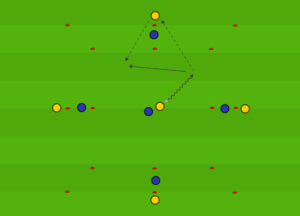
Look to play a 1-2 with outside an team mate.
Progression 2
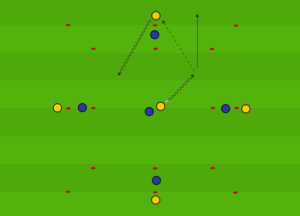
The receiving outside player dribbles in and switches places.
Why it Works
Players must keep hold of the ball while their team mates work to find space, as may happen in a game. Constant scanning of the playing area is a must for success. Being surrounded by 4 opponents while pressured by a 5th allows players to build their tolerance to being pressured by multiple opponents in a game.
It's not over 'Til the Fat Lady Sings
 In the first 30 minutes against England, Croatia looked like a team that had played two lots of 120 minutes followed by penalty shootouts in their previous two games. England started quickly, but as the game wore on, Croatia got a hold and showed their superior conditioning. During the first half of the World Cup Final, most were surprised at how they took the game to France, implementing an intense pressing game despite one less day's rest and having played more minutes with the same starting line up. That France were able to overcome that and win the competition is a credit to them.
In the first 30 minutes against England, Croatia looked like a team that had played two lots of 120 minutes followed by penalty shootouts in their previous two games. England started quickly, but as the game wore on, Croatia got a hold and showed their superior conditioning. During the first half of the World Cup Final, most were surprised at how they took the game to France, implementing an intense pressing game despite one less day's rest and having played more minutes with the same starting line up. That France were able to overcome that and win the competition is a credit to them.
The first team that I ever coached was a U11 boys team. We weren't the best (there's moments of my coaching then that I look and cringe about), but we were guaranteed to end every game piling pressure on the opposition. I believe that this was due to my employers insistence on aiming to keep the players active for 80% of each session.
What to Do Increase your Players Conditioning
Increase the intensity of your sessions. Doing conditioning specific work with the foundation ages is not only pointless, due to their physical make up, but mentally it's very boring. On top of that, laps around the field gets players fit to run laps around a field, not for a game of Football. Playing Football, gets players conditioned for a game of Football.
The intensity of the sessions can be increased by the following
Demonstrating at the speed at which you want the activity to run
Increasing the amount of balls on the move at one time (example activity)
Competition between groups (example activity)
Monitor how often and much you stop the players and talk. Try to keep players active for 75-80% of the session

